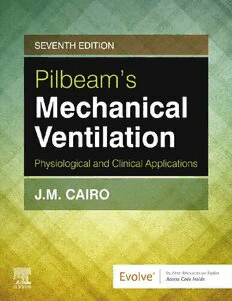
Pilbeam's Mechanical Ventilation: Physiological and Clinical Applications PDF
Preview Pilbeam's Mechanical Ventilation: Physiological and Clinical Applications
Pilbeam's Mechanical Ventilation Physiological and Clinical Applications SEVENTH EDITION J.M. Cairo, PhD, RRT, FAARC Dean of the School of Allied Health Professions, Professor of Cardiopulmonary Science, Physiology, and Anesthesiology, Louisiana State University Health Sciences Center, New Orleans, Louisiana Table of Contents Cover image Title page Copyright Dedication Contributors Preface Acknowledgments Chapter 1. Basic Terms and Concepts of Mechanical Ventilation Physiological Terms and Concepts Related to Mechanical Ventilation Normal Mechanics of Spontaneous Ventilation Lung Characteristics Time Constants Types of Ventilators and Terms Used in Mechanical Ventilation Types of Mechanical Ventilation Definition of Pressures in Positive Pressure Ventilation Summary Chapter 2. How Ventilators Work Historical Perspective on Ventilator Classification Internal Function Power Source or Input Power Control Systems and Circuits Power Transmission and Conversion System Summary Chapter 3. How a Breath Is Delivered Basic Model of Ventilation in the Lung During Inspiration Factors Controlled and Measured During Inspiration Overview of Inspiratory Waveform Control Phases of a Breath and Phase Variables Types of Breaths Summary Chapter 4. Establishing the Need for Mechanical Ventilation Acute Respiratory Failure Patient History and Diagnosis Physiological Measurements in Acute Respiratory Failure Overview of Criteria for Mechanical Ventilation Possible Alternatives to Invasive Ventilation Summary Chapter 5. Selecting the Ventilator and the Mode Noninvasive and Invasive Positive Pressure Ventilation: Selecting The Patient Interface Full and Partial Ventilatory Support Breath Delivery and Modes of Ventilation Modes of Ventilation Bilevel Positive Airway Pressure Additional Modes of Ventilation Summary Chapter 6. Initial Ventilator Settings Determining Initial Ventilator Settings During Volume-Controlled Ventilation Initial Settings During Volume-Controlled Ventilation Setting The Minute Ventilation: Special Considerations Inspiratory Pause During Volume Ventilation Determining Initial Ventilator Settings During Pressure Ventilation Setting Baseline Pressure: Physiological Positive End-Expiratory Pressure Summary Chapter 7. Final Considerations in Ventilator Setup Selection of Additional Parameters and Final Ventilator Setup Sensitivity Setting Alarms Periodic Hyperinflation or Sighing Final Considerations In Ventilator Equipment Setup Selecting the Appropriate Ventilator Evaluation of Ventilator Performance Chronic Obstructive Pulmonary Disease Asthma Neuromuscular Disorders Closed Head Injury Acute Respiratory Distress Syndrome Acute Cardiogenic Pulmonary Edema and Congestive Heart Failure Summary Chapter 8. Initial Patient Assessment Documentation of The Patient–Ventilator System The First 30 Minutes Monitoring Airway Pressures Vital Signs, Blood Pressure, and Physical Examination of The Chest Management of Endotracheal Tube and Tracheostomy Tube Cuffs Monitoring Compliance and Airway Resistance Comment Section of The Ventilator Flow Sheet Summary Chapter 9. Ventilator Graphics Relationship of Flow, Pressure, Volume, and Time A Closer Look at Scalars, Curves, and Loops Using Graphics to Monitor Pulmonary Mechanics Assessing Patient–Ventilator Asynchrony Advanced Applications Summary Chapter 10. Assessment of Respiratory Function Noninvasive Measurements of Blood Gases Capnography (Capnometry) Exhaled Nitric Oxide Monitoring Transcutaneous Monitoring Indirect Calorimetry and Metabolic Measurements Assessment of Respiratory System Mechanics Measurements Summary Chapter 11. Hemodynamic Monitoring Review of Cardiovascular Principles Obtaining Hemodynamic Measurements Interpretation of Hemodynamic Profiles Clinical Applications Summary Chapter 12. Methods to Improve Ventilation in Patient–Ventilator Management Correcting Ventilation Abnormalities Common Methods of Changing Ventilation Based on Paco2 and Ph Airway Clearance During Mechanical Ventilation Secretion Clearance From an Artificial Airway Administering Aerosols to Ventilated Patients Types of Aerosol-Generating Devices Postural Drainage and Chest Percussion Flexible Fiberoptic Bronchoscopy Additional Patient Management Techniques and Therapies in Ventilated Patients Fluid Balance Psychological and Sleep Status Patient Safety and Comfort Transport of Mechanically Ventilated Patients Within an Acute Care Facility Summary Chapter 13. Improving Oxygenation and Management of Acute Respiratory Distress Syndrome Basics of Oxygenation Using FIO2, PEEP Studies, and Pressure– Volume Curves for Establishing Optimal PEEP Introduction to Positive End-Expiratory Pressure and Continuous Positive Airway Pressure Peep Ranges Indications for PEEP and CPAP Initiating PEEP Therapy Selecting The Appropriate PEEP/CPAP Level (Optimal PEEP) Use of Pulmonary Vascular Pressure Monitoring with PEEP Contraindications and Physiological Effects of PEEP Weaning from PEEP Acute Respiratory Distress Syndrome Pathophysiology Changes in Computed Tomogram with ARDS ARDS as an Inflammatory Process PEEP and the Vertical Gradient in ARDS Lung-Protective Strategies: Setting Tidal Volume and Pressures in ARDS Long-Term Follow-Up on ARDS Pressure–Volume Loops and Recruitment Maneuvers in Setting PEEP in ARDS Summary of Recruitment Maneuvers in ARDS The Importance of Body Position During Positive Pressure Ventilation Additional Patient Cases Summary
